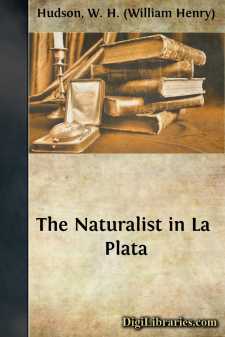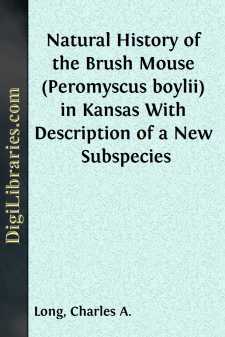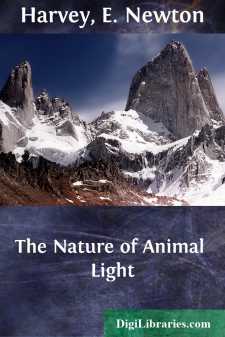Fiction
- Action & Adventure 180
- Biographical 15
- Christian 59
- Classics
- Coming of Age 5
- Contemporary Women 3
- Erotica 8
- Espionage/Intrigue 12
- Fairy Tales, Folklore & Mythology 236
- Family Life 169
- Fantasy 117
- Gay 1
- General 596
- Ghost 32
- Historical 808
- Horror 43
- Humorous 160
- Jewish 25
- Legal 4
- Medical 22
- Mystery & Detective 315
- Political 49
- Psychological 41
- Religious 64
- Romance 159
- Sagas 11
- Science Fiction 730
- Sea Stories 113
- Short Stories (single author) 537
- Sports 10
- Suspense 1
- Technological 8
- Thrillers 2
- Urban Life 31
- Visionary & Metaphysical 1
- War & Military 173
- Westerns 199
Classics Books
Sort by:
by:
Jon C. Barlow
INTRODUCTION The Bell Vireo (Vireo bellii Aud.) is a summer resident in riparian and second growth situations in the central United States south of North Dakota. In the last two decades this bird has become fairly common in western, and to a lesser extent in central, Indiana and is apparently shifting its breeding range eastward in that state (Mumford, 1952; Nolan, 1960). In northeastern Kansas the...
more...
The Sacramento Mountains Salamander, Aneides hardii (Taylor), is a plethodontid of relict distribution in the spruce-fir vegetational formation from 8500 to 9600 feet elevation in Otero and Lincoln counties, New Mexico. The salamanders on which most of this report is based were collected three, four, and six miles northeast of Cloudcroft in the Sacramento Mountains. Additional individuals were...
more...
CHAPTER I. THE DESERT PAMPAS. During recent years we have heard much about the great and rapid changes now going on in the plants and animals of all the temperate regions of the globe colonized by Europeans. These changes, if taken merely as evidence of material progress, must be a matter of rejoicing to those who are satisfied, and more than satisfied, with our system of civilization, or method of...
more...
by:
Charles A. Long
In order to determine the geographic distribution of the brush mouse in the state, 15 localities, chosen on the basis of suitable habitat, were investigated by means of snap-trapping in the winter and spring of 1959, spring of 1960, and winter and spring of 1961. Variation in specimens obtained by me and in other specimens in the Museum of Natural History, The University of Kansas, was analyzed....
more...
"I am getting very tired," said a hard brain-worker to me once. "Life is beginning to drag and lose its zest." This is an experience that can scarcely happen to one who has fallen in love with Nature, or become deeply interested in any of her almost infinite manifestations. Mr. and Mrs. Clifford of my story are not wholly the creations of fancy. The aged man sketched in the following...
more...
by:
E. Newton Harvey
CHAPTER ILIGHT-PRODUCING ORGANISMS The fact that animals can produce light must have been recognized from the earliest times in countries where fireflies and glowworms abound, but it is only since the perfection of the microscope that the phosphorescence of the sea, the light of damp wood and of dead fish and flesh has been proved to be due to living organisms. Aristotle mentions the light of dead fish...
more...
PREFACE The history of the naval events of the War of 1812 has been repeatedly presented both to the American and the English reader. Historical writers have treated it either in connection with a general account of the contest on land and sea, or as forming a part of the complete record of the navies of the two nations. A few monographs, which confine themselves strictly to the naval occurrences, have...
more...
INTRODUCTION The title chosen by its author for this little volume would assuredly commend it to the Naval Service, even if that author's name were not—as it is—a household word with more than one generation of naval officers. But to such of the general public as are not yet familiar with Mr Thursfield's writings a brief word of introduction may perhaps be useful. For the matters herein...
more...
THE NEGRO. What is his Ethnological Status? Is he the progeny of Ham? Is he a descendant of Adam and Eve? Has he a Soul? or is he a Beast, in God's nomenclature? What is his Status as fixed by God in creation? What is his relation to the White race? The intelligent will see at once, that the question of slavery,either right or wrong, is not involved in this caption for examination: nor is that...
more...
by:
Sydney Anderson
Tropical fruit-eating bats of the genus Artibeus reach their northern limits on the lowlands of the eastern and western coasts of México. Recent students have placed the species of Mexican Artibeus in two groups; one includes bats of small size and one includes bats of large size (Dalquest, 1953:61; Lukens and Davis, 1957:6; and Davis, 1958:163). Three of the small species (A. cinereus phaeotis, A....
more...











